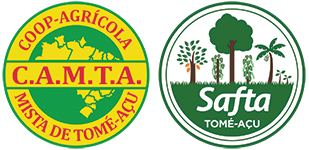Know our story
The Tomé-Açu Mixed Agricultural Cooperative (CAMTA) began its activities in 1929, founded by Japanese immigrants who sought to colonize the Tomé-Açu region of the state of Pará, cultivating cacao, vegetables and rice.
The adversities of the Amazon rainforest led to the failure of pioneer crops, which imposed extreme poverty on immigrants. The difficulties faced by Japanese immigrants were intensified as the emergence of tropical diseases, a fact that caused the abandonment of land by countless families of the Japanese colony, who migrated to other more structured cities of the country, seeking a better quality of life.
Black pepper culture, although introduced in 1930, prospered only after World War II, becoming the "Black Diamond", brought prosperity and wealth, generating the development of the region. At the time, Brazil was elevated to the level of the world's largest exporter of this piperaceous.
In the late 60's the decline of the golden phase of the black pepper began. The monocultures were decimated by a disease called “Fuzariose”, a fact that alerted immigrants to the need to implement techniques of diversification of the production system in the Amazon region.
Agroforestry crops began in the 1970s with the aim of overcoming the decay of Black Pepper monoculture, aiming at the economic stability of growers through the consortium of various fruit and forest plant species in the decaying areas of chili. of Kingdom. Thus diversifying production through the development of the Tomé-Açu Agroforestry System - SAFTA, which has made the region an important export hub for tropical fruits and a reference in the development, innovation and dissemination of SAFTA technology in Brazil, Bolivia and Ghana, Africa.
The verticalisation of production began in 1987 through financial support from the Japanese Government with the implementation of the Fruit Pulp Agro-Industry, which currently has the strength of 172 members, together with more than 1,800 family producers registered to supply raw materials. Since then, agroindustry has developed the region with economic, ecological and social sustainability, generating about 10,000 direct and indirect jobs, and fostering the economic stability of its members through the commercialization of Black Pepper, Cocoa Almonds, Oils. noble vegetables and 15 flavors of tropical fruit pulp nationally and internationally.
The adversities of the Amazon rainforest led to the failure of pioneer crops, which imposed extreme poverty on immigrants. The difficulties faced by Japanese immigrants were intensified as the emergence of tropical diseases, a fact that caused the abandonment of land by countless families of the Japanese colony, who migrated to other more structured cities of the country, seeking a better quality of life.
Black pepper culture, although introduced in 1930, prospered only after World War II, becoming the "Black Diamond", brought prosperity and wealth, generating the development of the region. At the time, Brazil was elevated to the level of the world's largest exporter of this piperaceous.
In the late 60's the decline of the golden phase of the black pepper began. The monocultures were decimated by a disease called “Fuzariose”, a fact that alerted immigrants to the need to implement techniques of diversification of the production system in the Amazon region.
Agroforestry crops began in the 1970s with the aim of overcoming the decay of Black Pepper monoculture, aiming at the economic stability of growers through the consortium of various fruit and forest plant species in the decaying areas of chili. of Kingdom. Thus diversifying production through the development of the Tomé-Açu Agroforestry System - SAFTA, which has made the region an important export hub for tropical fruits and a reference in the development, innovation and dissemination of SAFTA technology in Brazil, Bolivia and Ghana, Africa.
The verticalisation of production began in 1987 through financial support from the Japanese Government with the implementation of the Fruit Pulp Agro-Industry, which currently has the strength of 172 members, together with more than 1,800 family producers registered to supply raw materials. Since then, agroindustry has developed the region with economic, ecological and social sustainability, generating about 10,000 direct and indirect jobs, and fostering the economic stability of its members through the commercialization of Black Pepper, Cocoa Almonds, Oils. noble vegetables and 15 flavors of tropical fruit pulp nationally and internationally.



